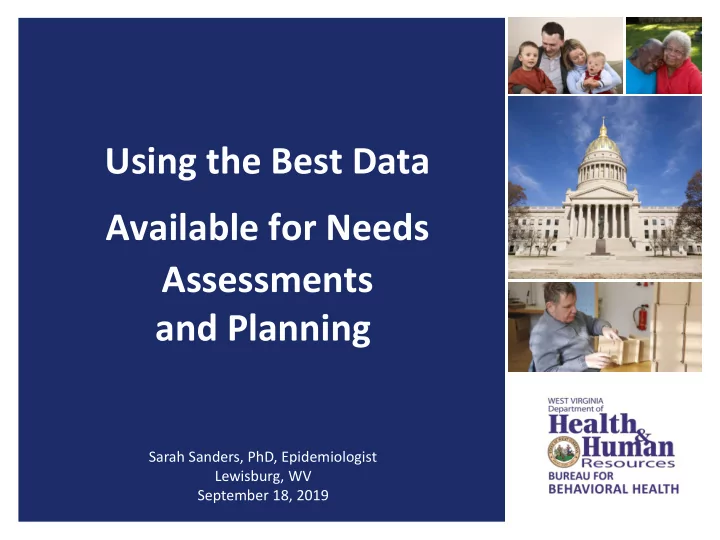

Using the Best Data Available for Needs Assessments and Planning Sarah Sanders, PhD, Epidemiologist Lewisburg, WV September 18, 2019
What Do You Think When I Say Needs Assessment? 1
What I Think When I Hear Needs Assessment • Data • Who, What, Where, When, How • Pragmatics and Feasibility • Funding, Resources, Cultural Environment • Priorities • Mine, My bosses, Funders, Community, Stakeholders • All the Feelings • Overwhelmed, Frustrated, Hope • Where to Start and When to End • Organizational Headaches 2
How I Feel 3
Because I Was Taught and Still Believe 4
Acceptance and Working Towards Change BAD Data = Best Available Data What can I change? • Constantly surprised What do I have to accept? • Constantly surprised 5
Needs Assessment 6 http://www.healthycommunities.org/Resources/toolkit.shtml#.XW70kEF7mM9
Reflect and Strategize • Why do you do what you do? • How do you do what you do? • What do you want to change? • Activities • Outcomes • Other • What do you have control over? 7
Needs Assessment 8 http://www.healthycommunities.org/Resources/toolkit.shtml#.XW70kEF7mM9
Define the Community • One county? • Several counties? • A group of interest? • Other? • How does data availability affect your definition of the community? • Proxy? 9
Needs Assessment 10 http://www.healthycommunities.org/Resources/toolkit.shtml#.XW70kEF7mM9
What Do You Think When I Say Data? 11
Quantitative 12
Qualitative 13
Both Matter 14 Source: Cartoon created by Indeed UX Research Manager Dave Yeats using cmx.io
Both Matter 15
Both Matter 16
Both Matter 17
Individuals Affected 18
Proportion of Population Affected? 19
Both Matter Number Number with a with a Pet Percent of 5% of Pet Percent of 5% of Population Gecko Population Population Population Gecko Population Population Wirt 5800 1000 17.2% 290 Kanawha 187827 1000 0.5% 9391 Tucker 7035 1000 14.2% 352 Berkeley 111610 1000 0.9% 5581 Pendleton 7138 1000 14.0% 357 Monongalia 103715 1000 1.0% 5186 Calhoun 7450 1000 13.4% 373 Cabell 96100 1000 1.0% 4805 Pleasants 7527 1000 13.3% 376 Wood 86016 1000 1.2% 4301 Gilmer 8305 1000 12.0% 415 Raleigh 77097 1000 1.3% 3855 Doddridge 8570 1000 11.7% 429 Harrison 68438 1000 1.5% 3422 Pocahontas 8574 1000 11.7% 429 Mercer 60963 1000 1.6% 3048 Webster 8637 1000 11.6% 432 Putnam 56644 1000 1.8% 2832 Clay 8901 1000 11.2% 445 Marion 56575 1000 1.8% 2829 20
Resources and Services We often forget to think about including these items. But in general what are you usually trying to increase? And for what purpose? 21
Sources What Data Sources Do You Use? 22
Sources How Do You Find Data Sources? 23
Sources Do You Use Online Query Data Sources? Data Requests? 24
Collect and Analyze Data • Primary vs. Other • Primary is usually more work, but also has more flexibility and control • Do you want to go and count everyone every year yourself? • Reports are easy to use and condense information in easy to use formats, but may not have exactly what you need • Prevention field is also hard in terms of data for many reasons • The effects of prevention are not always seen short term and when trends are increasing overall how do you show a slow down? • I always want to complicate things, but truthfully simple is best 25
Needs Assessment 26 http://www.healthycommunities.org/Resources/toolkit.shtml#.XW70kEF7mM9
Prioritize Needs • Numbers? Rates? Resources? • Workforce available? • Funding? • Nature vs. nurture argument – it’s always a 100% of both (except this case has usually more than two variables). • You know your communities. But back it up with data when able. 27
Needs Assessment 28 http://www.healthycommunities.org/Resources/toolkit.shtml#.XW70kEF7mM9
Document and Communicate Results Harder than it seems • Transparency • Appropriate comprehension level 29
Plan Implementation Keep in mind what you can do to achieve the big goal instead of just saying the big goal will happen Measure as you go • Baselines are crucial and a needs assessment can provide it 30
Example: Trained Teachers on Trauma Informed Practices • Direct result? • How do you measure it? • Timeframe? • Result of that result? • How do you measure it? • Timeframe? • Result of that result of the other result? • How do you measure it? • Timeframe? • Etc? 31
Needs Assessment 32 http://www.healthycommunities.org/Resources/toolkit.shtml#.XW70kEF7mM9
Implement Strategies Nothing goes as planned, change as needed Collect data that is relevant and required We come at it from a different angle, so talk to us about it Our requirements don’t mean you can’t do your own data collection 33
Needs Assessment 34 http://www.healthycommunities.org/Resources/toolkit.shtml#.XW70kEF7mM9
Evaluate Many, many, many definitions But it all comes down to two things (at least for me) ▪ Realistic outcomes ▪ Data that can guide programmatic changes We follow medical documentation rules….. ▪ It didn’t happen if there is no documentation…. 35
Data Links https://www.cdc.gov/healthyyouth/data/yrbs/index.htm http://wvde.state.wv.us/healthyschools/YRBS.htm https://wonder.cdc.gov/ https://factfinder.census.gov/faces/nav/jsf/pages/index.xhtml https://www.cdc.gov/drugoverdose/index.html https://www.cdc.gov/brfss/data_tools.htm https://www.countyhealthrankings.org/explore-health-rankings/measures-data- sources/2019-measures https://oeps.wv.gov/hiv-aids/Pages/default.aspx https://oeps.wv.gov/ob_hav/pages/default.aspx https://www.samhsa.gov/data/report/2014-2016-substate-estimates-substance-use-and- mental-illness https://grants6.tvisdata.hrsa.gov/PrioritiesAndMeasures/NationalPerformanceMeasures https://dhhr.wv.gov/bcf/Reports/Pages/Legislative-Foster-Care-Reports.aspx https://www.childtrends.org/wp-content/uploads/2017/09/West-Virginia-Child- Maltreatment-Factsheet_2015.pdf https://dhhr.wv.gov/vip/pages/default.aspx https://www.childhealthdata.org/browse/survey http://wvrha.org/wp-content/uploads/2019/03/2018-FINAL-WV-Workforce-updated- 9_26.pdf 36
How Am I Using Data • Big Ask – Do we have enough treatment beds? • But what does that actually mean? • Things I keep in mind: • Research vs. Emotion • What are the data points that I have available? • BBH data, Medicaid, Overdoses, etc., Do I know someone? • What data am I missing? • Can I get it and how? • Need vs. services • Bigger shortage is probably in out-patient treatment and how do I incorporate that? 37
Progress https://www.cdc.gov/nchs/nvss/vsrr/drug-overdose-data.htm 38
Contact Sarah Sanders, PhD Epidemiologist Department of Health and Human Resources Bureau for Behavioral Health 350 Capitol Street Room 350 Charleston, WV 25301 Phone: 304-356-4346 Fax: 304-558-1008 Email: Sarah.K.Sanders@wv.gov 39
Recommend
More recommend